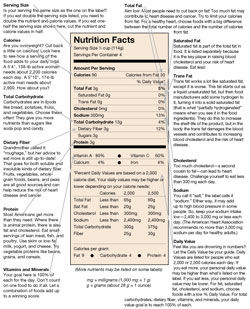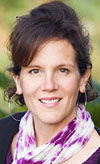
By MICHELLE ZIVE
What advice do you give your clients who want to lose weight? What do you think is the most important lifestyle change a person can make? Let us know your thoughts in the comment section below or join the conversation on the American Council on Exercise page on Facebook.
I’m going to tell you something you already know. Diets don’t work.
Most people can lose weight by restricting calories, but they can’t keep it off (Aphramor, 2010). And yet just about everybody is searching for that elusive magic formula—usually a restricted diet with specific foods to avoid—that will enable them to permanently (and easily) shed their excess pounds (Bacon and Aphramor, 2011).
Of course, permanent and lasting weight loss can’t be found in a formula—but believe it or not, this is actually good news for you and your clients. While only a registered dietitian can prescribe a diet, including a weight-loss diet, you can offer your clients something much more valuable—you can help them create a successful lifestyle-based weight-loss plan. With the proper tools—knowledge, skills and motivation—you can help your clients create healthy habits and ultimately, healthier lifestyles that include maintaining a healthy weight.
Knowledge
When it comes to nutrition, knowledge is power. In fact, being knowledgeable about good nutrition is associated with greater weight loss (Klohe-Lehman et al, 2006). And while most people think they know a lot about nutrition, your job is to assess exactly how much your client really knows about the principles of nutrition. For instance, knowing the energy equation doesn’t mean anything if a person doesn’t know how many calories he or she should be consuming to lose weight. While it is outside your scope of practice to recommend a specific caloric intake, you can introduce your clients to MyPyramid.gov: Steps to a Healthier You, which has a number of resources including a formula to determine how many calories a person needs a day to lose weight.
You also can offer your clients other important information related to weight loss. For example, what are the foods that satisfy hunger longer? Research shows people who eat vegetables and fruit, whole grains, low-calorie soups, and protein-rich foods are satisfied longer (Rolls et al, 2005). In fact, the body takes longer to digest protein than it does carbohydrates or fat (Halton and Hu, 2004). Nudge your clients towards protein-rich foods like eggs (egg whites have most of the protein compared to the yolk, which has the fat), part-skim mozzarella string cheese, and turkey breast. Did you know that 8 ounces of 100 percent apple juice has more calories than the same amount of regular soda? Encourage your clients to skip the juice and instead eat a whole apple, which has fewer calories, more nutrients and more fiber.
And while you’re recommending whole fruits over juices, teach your clients about the importance of choosing whole foods. Simply put, if you can identify a food by looking at it (e.g., carrots, air-popped popcorn, eggs), it is considerably more likely to be a food that is lower in calories and more satisfying than foods that are boxed, packaged or prepared.
Finally, there is no such thing as a “bad” food. Have we learned nothing from the vicious cycle of dieting, restriction and then binging on whatever food we were depriving ourselves of? Empower your clients with the knowledge that moderation is the key. Tell them to go ahead and have a small piece of cake. Occasionally treating oneself can be a huge help in maintaining a healthy lifestyle over the long term.
I’m going to make a confession. After the birth of my son, really three years after he was born, I looked in the mirror and realized I was overweight. How could a registered dietitian who had earned a master’s degree in nutrition and taken an exam for certification become fat? Basically, it was because I’d stopped practicing the skills of healthy eating. I knew, for example, that there were a lot of calories in a handful of trail mix, but until I started measuring out the nuts I didn’t realize my stomach had grown bigger than my eyes.
When it came to my weight, I needed help in honing my lifestyle skills—and you can offer this same guidance to your clients.
Skills
Skill is where knowledge gets put into action. Healthy lifestyle skills should be taught and practiced for the rest of a person’s life. Again, people can lose weight, but these are the skills that will help them keep it off.

- Keeping a food journal. Tracking food, beverages and portion sizes is probably the single most important skill a person can learn (and practice) to help change his or her eating habits (Kruger et al, 2006;). A study conducted by Kaiser Permanente’s Center for Health Research found that the more you track your food intake, the more weight you are likely to lose. Until I started keeping a journal I had no idea I was eating three times as much Cream of Wheat cereal than I should have been. Nor was I conscious of the fact that I was consuming a lot of food (and calories) at night. I also learned that I was frequently eating when I wasn’t hungry. By keeping a food journal, and seeing those things written down in black and white, I became aware of just how much I was eating. Food journals are available for free at http://www.sparkpeople.com/ and www.mypyramidtracker.gov. Regardless of what method is chosen, be sure your clients write down everything they eat and drink, including sips, nibbles and bites. Portion sizes are important, too. And while tracking can be a daunting task, encourage your clients to track as many days as possible. If, at the beginning, they only track for two days, congratulate them—and then ask them to track for three days the next week. And if a client is like many people who eat the same breakfast and lunch on most days, encourage him or her to start tracking everything eaten after lunch. This can be particularly effective because from early afternoon until bedtime seems to be the time of day when many people struggle most to control their eating. For more information, see the ACE Health eTips article on A Daily Food Log, Your Secret Weapon and the Ask the Expert blog post, How Do I Keep a Food Log?

- Grocery shopping and reading labels. Teaching a person how to shop the periphery of the grocery store with a grocery list is another important skill. And learning how to read food labels will enable them to stock the refrigerator and pantry with healthy, filling and low-calorie foods—a key component to successful weight loss and maintenance. Click the Figure to download a PDF (33K) for more information on how to decipher food labels.
- Cooking. Some people never learned how to cook. Others don’t know how to cook healthy foods to ensure they taste good, don’t get overcooked and remain nutritious without adding the wrong kind of fat to the recipe. There are a number of Web sites with some delicious and healthy recipes, including the American Council on Exercise. Make sure you have gone onto these sites and tested the recipes as well. If you’re not a cook, ask the people you work with or other clients to test them and provide feedback. Other ideas include:
- Offering cooking classes/demonstrations at your facility
- Connecting with local chefs or finding local cooking classed focused on healthy, low-fat, satisfying foods
- Introducing your clients to community gardens and farmer’s markets
- Starting a cooking support group that rotates to different homes
- Portion sizes. Test your clients on portion sizes. Pour 8 ounces of water into a large glass, and then do the same thing for a small cup. Ask them how much water is in each cup. Next, do the same thing with uncooked rice. Measure out ½ cup of the rice and put it on a small plate. Repeat the display on a large plate. Have your clients guess the amount. This exercise helps to create awareness about the fact that most of us don’t do a good job of estimating how much we’re eating. Encourage your clients to buy a food scale to weigh food, and count out the portion sizes based on the food label by using measuring cups and spoons. If a person isn’t at home and doesn’t have access to these tools, get visual aids online that make it easy to accurately estimate portion size.
- Intuitive eating. Most of us have cultural, psychological and emotional reasons for eating that aren’t related to feeding our bodies and satisfying physical hunger. Encourage your clients to practice intuitive eating. Evelyn Tribole and Elyse Resch, both dietitians, define intuitive eating as an “approach that teaches you how to create a healthy relationship with your food, mind and body—where you ultimately become the expert of your own body. In a study by Cole and Horacek (2010), 61 spouses of Fort Drum military personnel successfully transitioned away from a dieting mentality toward intuitive eating lifestyle behaviors. You can help teach your client the principals of intuitive eating by encouraging them to ask questions like, “Am I hungry? If I’m not hungry, why do I want to eat?” This process of checking in on hunger can help determine when a person is satisfied, too. By being in tune with the body’s signals and cues, a person can better “control” his or her food intake, including the number of calories and the kinds of foods she eats.
One of your jobs is to teach your client how to make SMART goals, which are Specific, Measurable, Attainable, Relevant and Time-bound. Which one of the following goals is a SMART goal?
- I want to lose weight.
- I want to lose 2 pounds this week by tracking everything I eat and drink for four days.
- I want to get down one pant size in four weeks by eliminating my coffee mochas and replacing them with nonfat lattes and eating a high-protein breakfast.
- I want to have more energy and feel better about myself by taking care of myself and treating myself as priority number one.
The answer is #2.
- The importance of goal setting. A client comes to you and says she wants to lose 50 pounds in a month. If the recommended weight loss per week is between 1.1 and 2.2 pounds a week (American College of Sports Medicine, 2010), is 50 pounds in one month realistic? Of course not. This is where goal setting comes in. Successful goal setting involves:
- Creating SMART goals (American Council on Exercise, 2011)
- Monitoring progress, including celebrating successes and discussing barriers
- Arranging the “environment” to guarantee success
- Recruiting support
While the topic of successful goal setting is beyond the scope of this article, I encourage you to take the time to learn how to help your clients set SMART and effective goals. For more information on SMART goals, refer to the ACE Lifestyle & Weight Management Coach Manual.
Motivation
So far we’ve covered the importance of helping your clients develop the knowledge and skills to follow a healthy lifestyle. Arguably, these are the easiest of your three tools for helping clients make healthier choices. After all, at the beginning of the process your clients are likely to be really motivated and have a strong desire to lose weight and to change their lifestyles. This is usually the time when people are successful at losing weight. But anyone who has actively tried to change the way they eat and the amount of activity they do knows that there will always be setbacks, hurdles and disappointments. It’s your job to keep clients motivated and coming back for more. Here are some effective ways to keep your clients engaged and motivated:
1.
Active listening. This means keeping your mouth shut, listening to what your client is saying, and not giving advice. Most of us are in this profession to help people, but most people want to be heard, not instructed.
2.
Practice one-minute motivation. Let’s say a client comes to you and says, “I’m eating too much at night. All I do is snack. And I’m not hungry.” You might want to tell them, "Don’t do that anymore."
A much better response: “What would you like to have happen when it comes to snacking at night?”
“I want to stop eating after dinner.”
“What will it take for this to happen?”
“I will have to stay away from the kitchen by calling a friend or walking my dog.”
“Can you call a friend or walk your dog instead of snacking at night?”
“Yes.”
“Will you?”
“Yes.”
3.
Be empathetic. Imagine what it’s like to be your client who is struggling to change eating habits that he or she has had for 50 years.
4.
Walk the walk. When appropriate, show your clients that you practice what you preach. Maybe you keep a food and activity journal. Perhaps you’re learning to cook tofu and vegetable-centric meals. Show your clients how you got rid of your trigger foods and found ways to treat yourself with these foods without having them around your house.
By teaching your clients about nutrition (and exercise), giving them skills to practice and being their coach, motivator, resource and supporter, you have the power and ability to change people’s lives for the better, today and well into the future.
_______________________________________________________________________
 Michelle Murphy Zive, M.S., R.D. has worked in community and nutrition research for the past 20 years at the University of California, San Diego, in the Division of Community Health. She's published more than 50 peer-reviewed articles on determinants of healthy eating and physical activity, as well as the impact of environment on health. Zive is the co-author, with Dr. Philip Nader, of You Can Prevent Childhood Obesity: Practical Ideas From Infancy to Adolescence, A Legacy of Health for Our Children. For more information on this book, go to www.youcanloseyourbabyfat.org.
Michelle Murphy Zive, M.S., R.D. has worked in community and nutrition research for the past 20 years at the University of California, San Diego, in the Division of Community Health. She's published more than 50 peer-reviewed articles on determinants of healthy eating and physical activity, as well as the impact of environment on health. Zive is the co-author, with Dr. Philip Nader, of You Can Prevent Childhood Obesity: Practical Ideas From Infancy to Adolescence, A Legacy of Health for Our Children. For more information on this book, go to www.youcanloseyourbabyfat.org.
References
American College of Sports Medicine (2010). ACSM's Guidelines for Exercise Testing and Prescription (8th ed.). Philadelphia: Wolters Kluwer/Lippincott, Williams & Wilkins.
American Council on Exercise (2011). ACE Lifestyle & Weight Management Coach Manual (2nd ed). San Diego, Calif.: American Council on Exercise.
Aphramor, L. (2010). Validity of claims made in weight management research: A narrative review of dietetic articles. Nutrition Journal, 9, 30, (www.nutritionj.com/content/10/1/9).
Bacon, L. and Aphramor, L. (2011). Weight science: Evaluating the evidence for a paradigm shift. Nutrition Journal, 10, 9, (www.nutritionj.com/content/10/1/9).
Halton, T.L. and Hu, F.B. (2004). The effects of high protein diets on thermogenesis, satiety and weight loss: A critical review. Journal of the American College of Nutrition, 23,5, 373–385.
Klohe-Lehman, D.M., et al (2006). Nutrition knowledge is associated with greater weight loss in obese and overweight low-income mothers. Journal of American Dietetic Association, 106, 6–75.
Kruger, J. et al. (2006) Dietary and physical activity behaviors among adults successful at weight loss maintenance. International Journal Behavioral Nutrition and Physical Activity, 19, 3, 17.
Maguire, M. and Pitceathly, C. (2002) Key communication skills and how to acquire them. British Medical Journal, 28, 697–700.
Rolls, B.J. et al. (2005) Changing the energy density of the diet as a strategy for weight management. Journal of American Dietetic Association, 105, S98–S103.